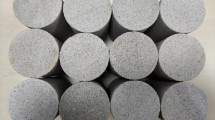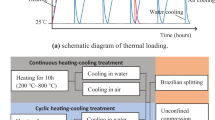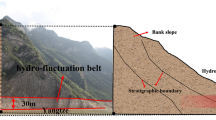Abstract
Understanding the micromechanical mechanism of the rock creep process is of great importance for studying the macroscopic time-dependent behavior of rocks. In this study, the evolution characteristics of the microstructure (cracks and pores) of saturated sandstones under short term and creep uniaxial compression conditions were investigated with the nuclear magnetic resonance (NMR) technique. The samples were first loaded to different stress levels and creep stages and then completely unloaded for NMR testing. Based on the testing results, the macroscopic deformation behavior, moisture migration law, pore size distribution, porosity, and microstructure change of the each sample under the short-term loading or different stages of creep were quantitatively analyzed. After that, by introducing a nonlinear elasto-viscoplastic damage creep model (EVP) by Zhao et al. (18:04017129, 2018), the relationships between the macroscopic irreversible strains and microscopic porosity increments were established. Overall, it was observed that: (1) regardless of the stress level, the magnitudes of the axial and lateral critical strains of samples at the onset of the accelerating creep stage are both relatively constant, and the axial strain is almost comparable to that at the peak stress in the short-term test, while the lateral strain is larger than that of the short-term test. (2) During the mechanical tests, the moisture in the samples migrates from large pores into small pores, and after mechanical tests, the porosities of the samples increase, in which the small pores always account for a larger proportion. (3) Corresponding to the three creep stages, the porosity of the sample increases slightly after the transient stage, increases to a constant value that is largely independent of stress after the steady stage, and increases significantly after the creep failure. In particular, compared to the initial porosity of 6.7%, the average porosities of samples taken to the onset of the tertiary stage and creep failure is 7.49% and 8.71%, increasing by 16.7% and 29.8%, respectively. (4) The porosity growth of sandstone during the brittle creep is mainly driven by the microscopic subcritical crack growth along the grain boundaries.

























Similar content being viewed by others
Data Availability
All data generated during the study are available from the corresponding author by request.
Abbreviations
- NMR:
-
Nuclear magnetic resonance
- XRD:
-
X-ray diffraction
- SEM:
-
Scanning electron microscope
- UCS:
-
Uniaxial compressive strength
- EVP creep model:
-
Nonlinear elasto-viscoplastic creep constitutive model
- \(\sigma _{0}\) :
-
Axial creep stress
- \(T_{2}\) :
-
Transverse relaxation time
- \(T_{{{\text{2S}}}}\) :
-
Transverse surface relaxation time
- \(\rho _{2}\) :
-
Surface relaxivity
- \(r\) :
-
Radius of pores
- \(\sigma _{{\text{P}}}\) :
-
Stress at the inflection point of rock compaction and dilatancy
- \(\varepsilon _{{\text{a}}}\), \(\varepsilon _{l}\), \(\varepsilon _{v}\) :
-
Axial, lateral, and volumetric strains of the sample
- \(t_{{S2}}\), \(t_{{\text{f}}}\) :
-
Time-to-onset of accelerating stage and time-to-failure
- \(T_{2} {\text{ cutoff}}\) :
-
Relaxation time separating mobile from immobile water
- \(\phi\) :
-
Porosity
- \(\phi _{{{\text{Si}}}}\) :
-
Initial porosity
- \(\phi _{{{\text{S0}}}}\) :
-
Porosity after short-term loading
- \(\phi _{{{\text{S1}}}}\) :
-
Porosity after transient creep stage
- \(\phi _{{{\text{S2}}}}\) :
-
Porosity after transient and steady creep stage
- \(\phi _{{{\text{S3}}}}\) :
-
Porosity after creep failure
- \(\phi _{s}\), \(\phi _{l}\) :
-
Porosity contributed by small pores and large pores
- \(D\) :
-
Creep damage variable
- \(\sigma _{s}\) :
-
Long-term strength
- \(E_{{{\text{ie}}}}\), \(E_{{{\text{ip}}}}\) :
-
Instantaneous elastic modulus and plastic modulus
- \(E_{{{\text{ve}}}}\), \(\eta _{{{\text{ve}}}}\) :
-
Viscoelastic parameters
- \(E_{{{\text{vp}}}}\), \(\eta _{{{\text{vp1}}}}\) :
-
Viscoplastic parameters
- \(\eta _{0}\) :
-
Initial viscosity coefficient
- \(\eta _{{{\text{vp}}2}}\) :
-
Viscoplastic viscosity coefficient
- \(k\), \(\gamma\) :
-
Material constants in EVP creep model
- \(\varepsilon _{{{\text{ie}}}}\), \(\varepsilon _{{{\text{ip}}}}\) :
-
Instantaneous elastic and plastic strains
- \(\varepsilon _{{{\text{vp}}}}\) :
-
Viscoplastic strain
- \(D_{{{\text{S2}}}}\) :
-
Creep damage variable at the onset of accelerating stage
References
Abdallah Y, Sulem J, Bornert M, Ghabezloo S, Stefanou I (2021) Compaction banding in high-porosity carbonate rocks: 1. experimental observations. J Geophys Res 126(1):e2020JB020538. https://doi.org/10.1029/2020JB020538
Amitrano D, Helmstetter A (2006) Brittle creep, damage, and time to failure in rocks. J Geophys Res. https://doi.org/10.1029/2005JB004252
Ashby MF, Sammis CG (1990) The damage mechanics of brittle solids in compression. Pure Appl Geophys 133(3):12. https://doi.org/10.1007/bf00878002
Baud P, Meredith PG (1997) Damage accumulation during triaxial creep of darley dale sandstone from pore volumometry and acoustic emission. Int J Rock Mech Min Sci 34(3):24.e21-24.e10. https://doi.org/10.1016/S1365-1609(97)00060-9
Brantut N, Baud P, Heap MJ, Meredith PG (2012) Micromechanics of brittle creep in rocks. Geophys Res 117(B8):12. https://doi.org/10.1029/2012JB009299
Brantut N, Heap MJ, Meredith PG, Baud P (2013) Time-dependent cracking and brittle creep in crustal rocks: a review. J Struct Geol 52:17–43. https://doi.org/10.1016/j.jsg.2013.03.007
Brantut N, Heap MJ, Baud P, Meredith PG (2014a) Mechanisms of time-dependent deformation in porous limestone. J Geophys Res 119(7):5444–5463. https://doi.org/10.1002/2014JB011186
Brantut N, Heap MJ, Baud P, Meredith PG (2014b) Rate- and strain-dependent brittle deformation of rocks. J Geophys Res 119(3):1818–1836. https://doi.org/10.1002/2013JB010448
Cai C, Li G, Huang Z, Shen Z, Tian S, Wei J (2014) Experimental study of the effect of liquid nitrogen cooling on rock pore structure. J Nat Gas Sci Eng 21:507–517. https://doi.org/10.1016/j.jngse.2014.08.026
Cao Y, Deng J, Yu B, Tan Q, Ma C (2014) Analysis of sandstone creep and wellbore instability prevention. J Nat Gas Sci Eng 19:237–243. https://doi.org/10.1016/j.jngse.2014.05.013
Chandler NA (2013) Quantifying long-term strength and rock damage properties from plots of shear strain versus volume strain. Int J Rock Mech Min Sci 59:105–110. https://doi.org/10.1016/j.ijrmms.2012.12.006
Charles RJ (1958) Static fatigue of glass. J Appl Phys 29(11):4
Chen M, Dai J, Liu X, Qin M, Pei Y, Wang Z (2018) Differences in the fluid characteristics between spontaneous imbibition and drainage in tight sandstone cores from nuclear magnetic resonance. Energy Fuels 32(10):10333–10343. https://doi.org/10.1021/acs.energyfuels.8b01396
Cheng H, Zhang Y, Zhou X (2021a) A nonlinear creep model for rocks considering damage evolution based on the modified Nishihara model. Int J Geomech. https://doi.org/10.1061/(ASCE)GM.1943-5622.0002071
Cheng H, Zhou X, Pan X, Berto F (2021b) Damage analysis of sandstone during the creep stage under the different levels of uniaxial stress using NMR measurements. Fatigue Fract Eng Mater Struct 44(3):719–732. https://doi.org/10.1111/ffe.13389
Chu Z, Wu Z, Liu Q, Liu B, Sun J (2021) Analytical solution for lined circular tunnels in deep viscoelastic burgers rock considering the longitudinal discontinuous excavation and sequential installation of liners. J Eng Mech. https://doi.org/10.1061/(ASCE)EM.1943-7889.0001912
Cong Y, Wang Z, Zheng Y, Zhang L (2020) Effect of unloading stress levels on macro- and microfracture mechanisms in brittle rocks. Int J Geomech 20(6):04020066. https://doi.org/10.1061/(ASCE)GM.1943-5622.0001647
Costin LS (1983) A microcrack model for the deformation and failure of brittle rock. J Geophys Res 88(B11):9485–9492. https://doi.org/10.1029/JB088iB11p09485
Deng HF, Zhou ML, Li JL, Sun XS, Huang YL (2016) Creep degradation mechanism by water-rock interaction in the red-layer soft rock. Arab J Geosci. https://doi.org/10.1007/s12517-016-2604-6
Fahimifar A, Karami M, Fahimifar A (2015) Modifications to an elasto-visco-plastic constitutive model for prediction of creep deformation of rock samples. Soils Found 55(6):1364–1371. https://doi.org/10.1016/j.sandf.2015.10.003
Fan LF, Gao JW, Wu ZJ, Yang SQ, Ma GW (2018) An investigation of thermal effects on micro-properties of granite by X-ray CT technique. Appl Therm Eng 140:505–519. https://doi.org/10.1016/j.applthermaleng.2018.05.074
Fan L, Gao J, Du X, Wu Z (2020) Spatial gradient distributions of thermal shock-induced damage to granite. J Rock Mech Geotech Eng 12(5):917–926. https://doi.org/10.1016/j.jrmge.2020.05.004
Gao F, Wang Q, Deng H, Zhang J, Tian W, Ke B (2017) Coupled effects of chemical environments and freeze–thaw cycles on damage characteristics of red sandstone. Bull Eng Geol Env 76(4):1481–1490. https://doi.org/10.1007/s10064-016-0908-0
Gao H, Wang C, Cao J, He M, Dou L (2019) Quantitative study on the stress sensitivity of pores in tight sandstone reservoirs of Ordos basin using NMR technique. J Petrol Sci Eng 172:401–410. https://doi.org/10.1016/j.petrol.2018.09.083
Guayacán-Carrillo L-M, Sulem J, Seyedi DM, Ghabezloo S, Armand G (2018) Size effect on the time-dependent closure of drifts in Callovo-Oxfordian claystone. Int J Geomech 18(10):04018128. https://doi.org/10.1061/(ASCE)GM.1943-5622.0001213
Hao L, Zuliang Z, Imo-Imo EK, Yong S, **nrong L, Dongmin Y (2020) Experimental investigation of the permeability and mechanical behaviours of chemically corroded limestone under different unloading conditions. Rock Mech Rock Eng 53(4):1587–1603. https://doi.org/10.1007/s00603-019-01961-y
Heap MJ, Baud P, Meredith PG, Bell AF, Main IG (2009) Time-dependent brittle creep in Darley Dale sandstone. J Geophys Res. https://doi.org/10.1029/2008JB006212
Heap MJ, Brantut N, Baud P, Meredith PG (2015) Time-dependent compaction band formation in sandstone. J Geophys Res 120(7):4808–4830. https://doi.org/10.1002/2015JB012022
Li XZ, Shao ZS (2016) Micro–macro modeling of brittle creep and progressive failure subjected to compressive loading in rock. Environ Earth Sci 75(7):583. https://doi.org/10.1007/s12665-016-5365-3
Li J, Kaunda RB, Zhou K (2018) Experimental investigations on the effects of ambient freeze-thaw cycling on dynamic properties and rock pore structure deterioration of sandstone. Cold Reg Sci Technol 154:133–141. https://doi.org/10.1016/j.coldregions.2018.06.015
Li S, Huo R, Yoshiaki F, Ren D, Song Z (2019) Effect of acid-temperature-pressure on the damage characteristics of sandstone. Int J Rock Mech Min Sci 122:104079. https://doi.org/10.1016/j.ijrmms.2019.104079
Li X, Shao Z, Qi C (2020) An analytical micro-macro model of stress drops during brittle creep in rocks. Eng Fract Mech 223:106794. https://doi.org/10.1016/j.engfracmech.2019.106794
Lin Y, Zhou K, Li J, Ke B, Gao R (2020) Weakening laws of mechanical properties of sandstone under the effect of chemical corrosion. Rock Mech Rock Eng 53(4):1857–1877. https://doi.org/10.1007/s00603-019-01998-z
Liu Y, Dai F (2018) A damage constitutive model for intermittent jointed rocks under cyclic uniaxial compression. Int J Rock Mech Min Sci 103:289–301. https://doi.org/10.1016/j.ijrmms.2018.01.046
Liu Z, Yang H, Wang W, Cheng W, **n L (2018) Experimental study on the pore structure fractals and seepage characteristics of a coal sample around a borehole in coal seam water infusion. Transp Porous Media 125(2):289–309. https://doi.org/10.1007/s11242-018-1119-x
Liu H, Li L, Li S, Yang W (2020) The time-dependent failure mechanism of rocks and associated application in slope engineering: An explanation based on numerical investigation. Math Probl Eng 2020:1680265. https://doi.org/10.1155/2020/1680265
Lu Y, Wang L, Ge Z, Zhou Z, Deng K, Zuo S (2020) Fracture and pore structure dynamic evolution of coals during hydraulic fracturing. Fuel 259:116272. https://doi.org/10.1016/j.fuel.2019.116272
Lyu C, Ning Z, Cole DR, Wang Q, Chen M (2020) Experimental investigation on T2 cutoffs of tight sandstones: Comparisons between outcrop and reservoir cores. J Petrol Sci Eng 191:107184. https://doi.org/10.1016/j.petrol.2020.107184
Ma L, Liu X, Fang Q, Xu H, **a H, Li E, Li W (2012) A new elasto-viscoplastic damage model combined with the generalized Hoek-Brown failure criterion for bedded rock salt and its application. Rock Mech Rock Eng 46(1):53–66. https://doi.org/10.1007/s00603-012-0256-8
Ma D, Duan H, Li X, Li Z, Zhou Z, Li T (2019) Effects of seepage-induced erosion on nonlinear hydraulic properties of broken red sandstones. Tunn Undergr Space Technol 91:102993. https://doi.org/10.1016/j.tust.2019.102993
Main IG (2000) A damage mechanics model for power-law creep and earthquake aftershock and foreshock sequences. Geophys J Int 142(1):11. https://doi.org/10.1046/j.1365-246x.2000.00136.x
Ngwenya BT, Main IG, Elphick SC, Crawford BR, Smart BGD (2001) A constitutive law for low-temperature creep of water-saturated sandstones. J Geophys Res 106(B10):21811–21826. https://doi.org/10.1029/2001JB000403
Nicksiar M, Martin CD (2013) Crack initiation stress in low porosity crystalline and sedimentary rocks. Eng Geol 154:64–76. https://doi.org/10.1016/j.enggeo.2012.12.007
Noël C, Pimienta L, Violay M (2019) Time-dependent deformations of sandstone during pore fluid pressure oscillations: Implications for natural and induced seismicity. J Geophys Res 124(1):801–821. https://doi.org/10.1029/2018JB016546
Paterson MS, Wong TF (2005) Experimental rock deformation-the brittle field, 2nd edn. Springer, Berlin
Shen Y, Wang Y, Wei X, Jia H, Yan R (2020) Investigation on meso-debonding process of the sandstone-concrete interface induced by freeze-thaw cycles using NMR technology. Constr Build Mater 252:118962. https://doi.org/10.1016/j.conbuildmat.2020.118962
Tang SB, Yu CY, Heap MJ, Chen PZ, Ren YG (2018) The influence of water saturation on the short- and long-term mechanical behavior of red sandstone. Rock Mech Rock Eng 51(9):2669–2687. https://doi.org/10.1007/s00603-018-1492-3
Tian H, Chen W, Yang D, Gong Z (2015) Experimental and numerical analysis of the time-dependent behaviour of argillaceous red sandstone under high in situ stress. Bull Eng Geol Env 74(2):567–575
Tsai LS, Hsieh YM, Weng MC, Huang TH, Jeng FS (2008) Time-dependent deformation behaviors of weak sandstones. Int J Rock Mech Min Sci 45(2):144–154. https://doi.org/10.1016/j.ijrmms.2007.04.008
Wang M, Cai M (2020) A grain-based time-to-failure creep model for brittle rocks. Comput Geotech 119:103344. https://doi.org/10.1016/j.compgeo.2019.103344
Wang R, Li L, Simon R (2019) A model for describing and predicting the creep strain of rocks from the primary to the tertiary stage. Int J Rock Mech Min Sci 123:104087. https://doi.org/10.1016/j.ijrmms.2019.104087
Wang C, Liu J, Chen L, Liu J, Wang L (2020a) Mechanical behaviour and damage evolution of Beishan granite considering the transient and time-dependent effects of excavation unloading. Eur J Environ Civil Eng. https://doi.org/10.1080/19648189.2020.1784292
Wang F, Cao P, Wang Y, Hao R, Meng J, Shang J (2020b) Combined effects of cyclic load and temperature fluctuation on the mechanical behavior of porous sandstones. Eng Geol 266:105466. https://doi.org/10.1016/j.enggeo.2019.105466
Wen T, Tang H, Ma J, Wang Y (2018) Evaluation of methods for determining crack initiation stress under compression. Eng Geol 235:81–97. https://doi.org/10.1016/j.enggeo.2018.01.018
Weng L, Wu Z, Li X (2018) Mesodamage characteristics of rock with a pre-cut opening under combined static–dynamic loads: a nuclear magnetic resonance (NMR) investigation. Rock Mech Rock Eng 51(8):2339–2354. https://doi.org/10.1007/s00603-018-1483-4
Weng L, Wu Z, Liu Q (2019) Evaluating damage and microcracking behavior of granite using NMR testing under different levels of unconfined compression. Int J Geomech 19(1):04018186. https://doi.org/10.1061/(ASCE)GM.1943-5622.0001335
Weng L, Wu Z, Liu Q, Chu Z, Zhang S (2021) Evolutions of the unfrozen water content of saturated sandstones during freezing process and the freeze-induced damage characteristics. Int J Rock Mech Min Sci 142:104757. https://doi.org/10.1016/j.ijrmms.2021.104757
Wong T-F, Baud P (2012) The brittle-ductile transition in porous rock: a review. J Struct Geol 44:25–53. https://doi.org/10.1016/j.jsg.2012.07.010
Wu XY, Baud P, Wong T (2000) Micromechanics of compressive failure and spatial evolution of anisotropic damage in Darley Dale sandstone. Int J Rock Mech Min Sci 37(1):143–160. https://doi.org/10.1016/S1365-1609(99)00093-3
Wu K, Shao Z, Qin S (2020) An analytical design method for ductile support structures in squeezing tunnels. Archiv Civ Mech Eng 20(3):91. https://doi.org/10.1007/s43452-020-00096-0
Xue DJ, Zhou HW, Liu YT, Deng LS, Zhang L (2018) Study of drainage and percolation of nitrogen-water flooding in tight coal by NMR imaging. Rock Mech Rock Eng 51(11):3421–3437. https://doi.org/10.1007/s00603-018-1473-6
Yang SQ, Hu B (2018) Creep and long-term permeability of a red sandstone subjected to cyclic loading after thermal treatments. Rock Mech Rock Eng 51(10):2981–3004. https://doi.org/10.1007/s00603-018-1528-8
Yang SQ, Jiang Y (2010) Triaxial mechanical creep behavior of sandstone. Mining Sci Technol 20(3):339–349. https://doi.org/10.1016/s1674-5264(09)60206-4
Yang SQ, **g HW, Cheng L (2014a) Influences of pore pressure on short-term and creep mechanical behavior of red sandstone. Eng Geol 179(10):10–23. https://doi.org/10.1016/j.enggeo.2014.06.016
Yang W, Zhang Q, Li S, Wang S (2014b) Time-dependent behavior of diabase and a nonlinear creep model. Rock Mech Rock Eng 47(4):1211–1224. https://doi.org/10.1007/s00603-013-0478-4
Yang S, Hu B, Ranjith P, Xu P (2018) Multi-step loading creep behavior of red sandstone after thermal treatments and a creep damage model. Energies 11(1):10. https://doi.org/10.3390/en11010212
Yu C, Tang S, Tang CA, Duan D, Zhang Y, Ma T (2019) The effect of water on the creep behavior of red sandstone. Eng Geol 253:64–74. https://doi.org/10.1016/j.enggeo.2019.03.016
Yu J, Yao W, Duan K, Liu X, Zhu Y (2020) Experimental study and discrete element method modeling of compression and permeability behaviors of weakly anisotropic sandstones. Int J Rock Mech Min Sci 134:104437. https://doi.org/10.1016/j.ijrmms.2020.104437
Zhang Y, Shao J, Xu W, Jia Y, Zhao H (2015) Creep behaviour and permeability evolution of cataclastic sandstone in triaxial rheological tests. Eur J Environ Civ Eng 19(4):496–519. https://doi.org/10.1080/19648189.2014.960103
Zhao Y, Zhang L, Wang W, Wan W, Ma W (2018) Separation of elastoviscoplastic strains of rock and a nonlinear creep model. Int J Geomech 18(1):04017129. https://doi.org/10.1061/(ASCE)GM.1943-5622.0001033
Zheng H, Feng X, Hao X (2015) A creep model for weakly consolidated porous sandstone including volumetric creep. Int J Rock Mech Min Sci 78:99–107. https://doi.org/10.1016/j.ijrmms.2015.04.021
Zheng Z, Sun W, Fish J (2016) Micropolar effect on the cataclastic flow and brittle-ductile transition in high-porosity rocks. J Geophys Res 121(3):1425–1440. https://doi.org/10.1002/2015JB012179
Zhou K, Liu T, Hu Z (2018a) Exploration of damage evolution in marble due to lateral unloading using nuclear magnetic resonance. Eng Geol 244:75–85. https://doi.org/10.1016/j.enggeo.2018.08.001
Zhou X, Huang X, Berto F (2018b) A three-dimensional long-term strength criterion of rocks based on micromechanical method. Theoret Appl Fract Mech 97:409–418. https://doi.org/10.1016/j.tafmec.2017.07.003
Zhu W, Li S, Li S, Niu L (2019) Influence of dynamic disturbance on the creep of sandstone: An experimental study. Rock Mech Rock Eng 52(4):1023–1039. https://doi.org/10.1007/s00603-018-1642-7
Acknowledgements
The research work was financially supported by the National Natural Science Foundation of China (Grant Nos. 51908431, 42077246), for which the authors are grateful.
Author information
Authors and Affiliations
Corresponding author
Ethics declarations
Conflict of interest
The authors declare that they have no conflicts of interest.
Additional information
Publisher's Note
Springer Nature remains neutral with regard to jurisdictional claims in published maps and institutional affiliations.
Rights and permissions
About this article
Cite this article
Chu, Z., Wu, Z., Liu, Q. et al. Evaluating the Microstructure Evolution Behaviors of Saturated Sandstone Using NMR Testing Under Uniaxial Short-Term and Creep Compression. Rock Mech Rock Eng 54, 4905–4927 (2021). https://doi.org/10.1007/s00603-021-02538-4
Received:
Accepted:
Published:
Issue Date:
DOI: https://doi.org/10.1007/s00603-021-02538-4




